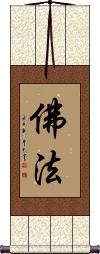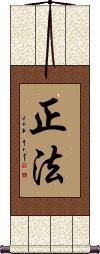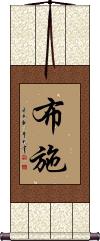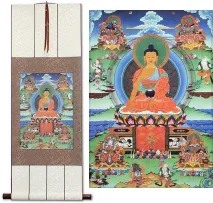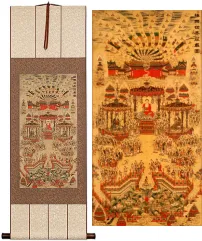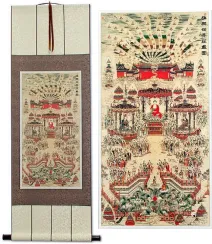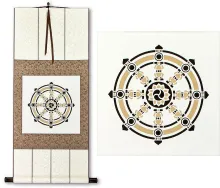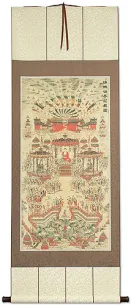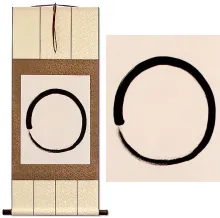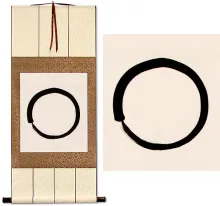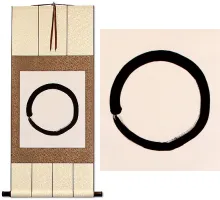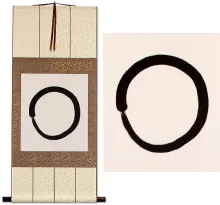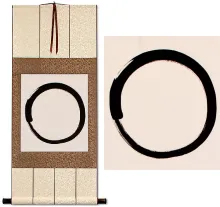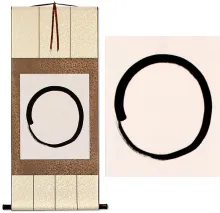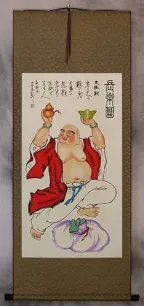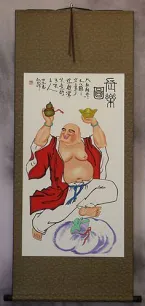Many custom options...
And formats...

Dharma Buddhist Doctrine in Chinese / Japanese...
Buy a Dharma Buddhist Doctrine calligraphy wall scroll here!
Personalize your custom “Dharma Buddhist Doctrine” project by clicking the button next to your favorite “Dharma Buddhist Doctrine” title below...
Dharma / Buddhist Doctrine
Dharma / The Law
法 is the simple way to write “law” or in a Buddhist context “Dharma.”
This can also mean method, way, or Buddhist teaching. It's also an abbreviation for the country of France.
The Buddhist context exists in Chinese and Korean Hanja but I have not yet confirmed that this means more than “law” when used alone in Japanese.
Shobo
The correct doctrine of the Buddha
正法 is a Buddhist term that means “True Dharma” or “The true teachings of Buddha.”
Other translations include the just law, proper method, or period of the true law.
Dana: Almsgiving and Generosity
布施 is the Buddhist practice of giving known as Dāna or दान from Pali and Sanskrit.
Depending on the context, this can be alms-giving, acts of charity, or offerings (usually money) to a priest for reading sutras or teachings.
Some will put Dāna in these two categories:
1. The pure or unsullied charity, which looks for no reward here but only in the hereafter.
2. The sullied almsgiving whose object is personal benefit.
The first kind is, of course, the kind that a liberated or enlightened person will pursue.
Others will put Dāna in these categories:
1. Worldly or material gifts.
2. Unworldly or spiritual gifts.
You can also separate Dāna into these three kinds:
1. 財布施 Goods such as money, food, or material items.
2. 法布施 Dharma, as an act to teach or bestow the Buddhist doctrine onto others.
3. 無畏布施 Courage, as an act of facing fear to save someone or when standing up for someone or standing up for righteousness.
The philosophies and categorization of Dāna will vary among various monks, temples, and sects of Buddhism.
Breaking down the characters separately:
布 (sometimes written 佈) means to spread out or announce, but also means cloth. In ancient times, cloth or robs were given to the Buddhist monks annually as a gift of alms - I need to do more research, but I believe there is a relationship here.
施 means to grant, to give, to bestow, to act, to carry out, and by itself can mean Dāna as a single character.
Dāna can also be expressed as 檀那 (pronounced “tán nà” in Mandarin and dan-na or だんな in Japanese). 檀那 is a transliteration of Dāna. However, it has colloquially come to mean some unsavory or unrelated things in Japanese. So, I think 布施 is better for calligraphy on your wall to remind you to practice Dāna daily (or whenever possible).
This in-stock artwork might be what you are looking for, and ships right away...
Gallery Price: $200.00
Your Price: $88.88
Gallery Price: $200.00
Your Price: $69.88
Not the results for dharma buddhist doctrine that you were looking for?
Below are some entries from our dictionary that may match your dharma buddhist doctrine search...
| Characters If shown, 2nd row is Simp. Chinese |
Pronunciation Romanization |
Simple Dictionary Definition |
佛法 see styles |
fó fǎ fo2 fa3 fo fa buppō |
More info & calligraphy: Dharma / Buddhist Doctrinebuddhadharma; the Dharma or Law preached by the Buddha, the principles underlying these teachings, the truth attained by him, its embodiment in his being. Buddhism. |
法輪 法轮 see styles |
fǎ lún fa3 lun2 fa lun hourin / horin ほうりん |
More info & calligraphy: Eternal Wheel of Life{Buddh} (See 輪宝,転法輪) the teachings of Buddha (as likened to the Dharmachakra, originally a wheel-like weapon used to destroy the evils of mankind); Buddhist doctrine; (surname) Noriwa dharmacakra, the Wheel of the Law, Buddha-truth which is able to crush all evil and all opposition, like Indra's wheel, and which rolls on from man to man, place to place, age to age. 轉法輪To turn, or roll along the Law-wheel, i.e. to preach Buddha-truth. |
竺法 see styles |
zhú fǎ zhu2 fa3 chu fa |
Dharma (the teachings of the Buddha, archaic); Buddhist doctrine |
達磨 达磨 see styles |
dá mó da2 mo2 ta mo daruma(p); daruma だるま(P); ダルマ |
(1) (kana only) daruma; tumbling doll; round, red-painted good-luck doll in the shape of Bodhidharma, with a blank eye to be completed when a person's wish is granted; (2) (kana only) Bodhidharma; (3) prostitute; (personal name) Daruma dharma; also 達摩; 達麼; 達而麻耶; 曇摩; 馱摩 tr. by 法. dharma is from dhara, holding, bearing, possessing, etc.; and means 'that which is to be held fast or kept, ordinance, statute, law, usage, practice'; 'anything right.' M.W. It may be variously intp. as (1) characteristic, attribute, predicate; (2) the bearer, the transcendent substratum of single elements of conscious life; (3) element, i.e. a part of conscious life; (4) nirvāṇa, i.e. the Dharma par excellence, the object of Buddhist teaching; (5) the absolute, the real; (6) the teaching or religion of Buddha; (7) thing, object, appearance. Also, Damo, or Bodhidharma, the twenty-eighth Indian and first Chinese patriarch, who arrived in China A.D. 520, the reputed founder of the Chan or Intuitional School in China. He is described as son of a king in southern India; originally called Bodhitara. He arrived at Guangdong, bringing it is said the sacred begging-bowl, and settled in Luoyang, where he engaged in silent meditation for nine years, whence he received the title of wall-gazing Brahman 壁觀婆羅門, though he was a kṣatriya. His doctrine and practice were those of the 'inner light', independent of the written word, but to 慧可 Huike, his successor, he commended the Laṅkāvatāra-sūtra as nearest to his views. There are many names with Dharma as initial: Dharmapāla, Dharmagupta, Dharmayaśas, Dharmaruci, Dharmarakṣa, Dharmatrāta, Dharmavardhana, etc. |
曼荼羅 曼荼罗 see styles |
màn tú luó man4 tu2 luo2 man t`u lo man tu lo mandara まんだら |
(Buddhism) (loanword from Sanskrit) mandala mandala; Buddhist visual schema of the enlightened mind; (given name) Mandara 曼怛羅; 曼特羅; 曼陀羅; 曼拏羅; 蔓陀囉; 滿荼邏 maṇḍala, a circle, globe, wheel ring; "any circular figure or diagram" (M.W.); a magic circle; a plot or place of enlightenment; a round or square altar on which buddhas and bodhisattvas are placed; a group of such, especially the garbhadhātu and vajradhātu groups of the Shingon sect; these were arranged by Kōbō Daishi to express the mystic doctrine of the two dhātu by way of illustration, the garbhadhātu representing the 理 and the 因 principle and cause, the vajradhātu the 智 and the 果 intelligence (or reason) and the effect, i.e. the fundamental realm of being, and mind as inherent in it; v. 胎 and 金剛. The two realms are fundamentally one, as are the absolute and phenomenal, e.g. water and wave. There are many kinds of maṇḍalas, e.g. the group of the Lotus Sutra; of the 觀經; of the nine luminaries; of the Buddha's entering into nirvana, etc. The real purpose of a maṇḍala is to gather the spiritual powers together, in order to promote the operation of the dharma or law. The term is commonly applied to a magic circle, subdivided into circles or squares in which are painted Buddhist divinities and symbols. Maṇḍalas also reveal the direct retribution of each of the ten worlds of beings (purgatory, pretas, animals, asuras, men, devas, the heavens of form, formless heavens, bodhisattvas, and buddhas). Each world has its maṇḍala which represents the originating principle that brings it to completion. The maṇḍala of the tenth world indicates the fulfilment and completion of the nine worlds. |
華嚴宗 华严宗 see styles |
huá yán zōng hua2 yan2 zong1 hua yen tsung Kegon Shū |
Chinese Buddhist school founded on the Buddhavatamsaka-mahavaipulya Sutra (Garland sutra) The Huayan (Kegon) school, whose foundation work is the Avataṃsaka-sūtra; founded in China by 帝心杜順 Dixin Dushun; he died A.D. 640 and was followed by 雲華智嚴 Yunhua Zhiyan; 賢首法藏 Xianshou Fazang; 淸涼澄觀 Qingliang Chengguan; 圭峯宗密 Guifeng Zongmi, and other noted patriarchs of the sect; its chief patron is Mañjuśrī. The school was imported into Japan early in the Tang dynasty and flourished there. It held the doctrine of the 法性 Dharma-nature, by which name it was also called. |
妙法蓮華 妙法莲华 see styles |
miào fǎ lián huá miao4 fa3 lian2 hua2 miao fa lien hua myōhō renge |
法華 The wonderful truth as found in the Lotus Sutra. the One Vehicle Sutra; which is said to contain 實法 Buddha's complete truth as compared with his previous 權法 or 方便法, i.e. partial, or expedient teaching, but both are included in this perfect truth. The sutra is the Saddhamapuṇḍarīka 正法華經 or (添品妙法蓮華經) 妙法蓮華經, also known as 薩曇芥陀利經, of which several translations in whole or part were made from Sanskrit into Chinese, the most popular being by Kumārajīva. It was the special classic of the Tiantai school, which is sometimes known as the 蓮宗 Lotus school, and it profoundly influenced Buddhist doctrine in China, Japan, and Tibet. The commentaries and treatises on it are very numerous; two by Chih-i 智顗 of the Tiantai school being the妙法蓮華經文句 and the 玄義. |
The following table may be helpful for those studying Chinese or Japanese...
| Title | Characters | Romaji (Romanized Japanese) | Various forms of Romanized Chinese | |
| Dharma Buddhist Doctrine | 佛法 | fó fǎ / fo2 fa3 / fo fa / fofa | ||
| Dharma The Law | 法 | hou / ho | fǎ / fa3 / fa | |
| Shobo | 正法 | shou bou / shoubou / sho bo | zhèng fǎ / zheng4 fa3 / zheng fa / zhengfa | cheng fa / chengfa |
| Dana: Almsgiving and Generosity | 布施 | fuse | bù shī / bu4 shi1 / bu shi / bushi | pu shih / pushih |
Successful Chinese Character and Japanese Kanji calligraphy searches within the last few hours...
